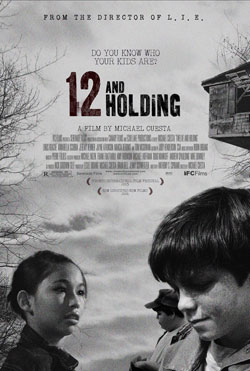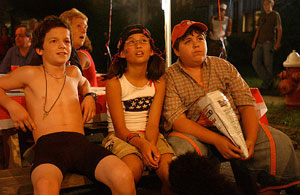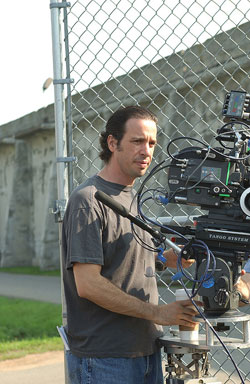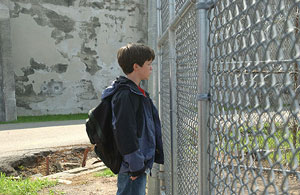 Michael Cuesta’s first feature, L.I.E., was one of the first films I ever reviewed for CHUD. That review seems to have become lost in the ether, which just goes to show you how long it’s been between films for Cuesta. His latest is 12 and Holding, and it again is about young people in the suburbs. This time it follows three kids – Jacob, Malee and Leonard – who suffer a terrible tragedy. Their best friend, and Jacob’s twin brother, is killed in a fire when two bullies throw Molotov cocktails at their treehouse. Leonard, who is grossly overweight, suffers a head injury in the attack and can no longer smell or taste. As he loses interest in eating and starts losing weight, he is put in conflict with his fat family. Malee’s dealing with her budding sexuality by focusing on a construction worker who turns out to have a dark past. Things are tougher for Jacob, who blames himself for his brother’s death and who thinks his parents would rather have lost him. He strikes up a bizarre and secret friendship with one of the boys responsible for his brother’s death.
Michael Cuesta’s first feature, L.I.E., was one of the first films I ever reviewed for CHUD. That review seems to have become lost in the ether, which just goes to show you how long it’s been between films for Cuesta. His latest is 12 and Holding, and it again is about young people in the suburbs. This time it follows three kids – Jacob, Malee and Leonard – who suffer a terrible tragedy. Their best friend, and Jacob’s twin brother, is killed in a fire when two bullies throw Molotov cocktails at their treehouse. Leonard, who is grossly overweight, suffers a head injury in the attack and can no longer smell or taste. As he loses interest in eating and starts losing weight, he is put in conflict with his fat family. Malee’s dealing with her budding sexuality by focusing on a construction worker who turns out to have a dark past. Things are tougher for Jacob, who blames himself for his brother’s death and who thinks his parents would rather have lost him. He strikes up a bizarre and secret friendship with one of the boys responsible for his brother’s death.
It’s not an easy film, but who expect easy from the guy whose first movie was the tender story of a young boy in love with Brian Cox? I had a chance to talk with Cuesta on the phone earlier this week, the results of which are presented here for your perusal. 12 and Holding opens in New York this weekend.
Q: 12 and Holding hits on some thematic ground that’s similar to your first feature, L.I.E.; children approaching adolescence. Was there ever a concern that you might get pigeonholed?
Cuesta: Pigeonhole me as a director where people only think of me only doing this kind of film? I definitely want to tell other stories. How should I say – more adult stories. And I’m working on them. But no, I had no concern. The story spoke to me. I didn’t write this particular one, but it spoke to me and I couldn’t shake it. So I had to do it.
Q: What do you think adolescents can tell us about ourselves as grownups?
Cuesta: I think one of the more fascinating things about the script was how wise these kids are. How they can impart their wisdom to us in some way. They always teach you something; they definitely hold a mirror to the adult world. They very much have to suffer the sins.
Q: It’s been so long between this film and L.I.E. Why the gap between projects?
Cuesta: It’s just hard to make a movie! There’s a book I adapted, and I focused on getting that made, which I still am. And I had to go back to my day job. I got sent a lot of stuff, and  a lot of the material was even more similar to L.I.E., and I wasn’t interested in that. When I say more similar I mean specifically about intergenerational relationships between a boy and a man. I guess when that film came out it unearthed a lot of stories that were out there in development that no one was willing to look at until there was a filmmaker that put it out there.
a lot of the material was even more similar to L.I.E., and I wasn’t interested in that. When I say more similar I mean specifically about intergenerational relationships between a boy and a man. I guess when that film came out it unearthed a lot of stories that were out there in development that no one was willing to look at until there was a filmmaker that put it out there.
Q: What’s the book you adapted?
Cuesta: It’s the Miracle Life of Edgar Mint. Funnily enough, it’s another story about an adolescent. The thing is with 12 & Holding, I was thick into adapting Edgar Mint and/or trying to get it made, we’d already finished our third draft on it, and we thought it was ready to go and then it didn’t. So 12 & Holding in a way filled that slot for me, where I was at the time.
It’s about a Native American kid that’s orphaned by this horrific car accident. He’s run over by a mail truck. He goes into a coma and when he awakens his whole life is gone; his mother, his friends, everything. He’s an orphan, and it’s basically the story of this kid. It’s an Oliver Twist-like odyssey of him finding a home. It takes place on the American plains with Mormons and Native Americans, this whole picaresque kind of world that surrounds him. It’s not the suburban milieu of L.I.E. and 12. It deals very much with a different world, a lot of wayward figures.
Q: One of the things that’s interesting about 12 and Holding is that you don’t have to cast one kid who will hold down a heavy story, but three kids who have to hold down three heavy stories. You really pulled it off. How difficult was the casting process?
Cuesta: It took a while. I would say it’s the most unnerving part of the whole thing because I knew that if I slipped up there the film would go off the tracks, so to speak. You work hard and you spend time looking for these no-name kids and you hope the stars are aligned for luck. I’ve been lucky enough to find them on both of my films.
Q: How as a director do you work with the child actors?
Cuesta: You know, they’re not that young. On 12 and Holding people call them children, but these are 12 year olds when we shot. They are wise way beyond their years, and smarter intellectually. That makes it very, very easy for me, because coming into it they had a very clear understanding of their characters and what they’re going through.
I talk about it a lot, but what they’re going through are extreme situations, but these are things kids think about and go through – some of them – every day. As adults we forget that kids are struggling with their budding sexuality and do those things. So they know, they’re kind of dealing with it right now. I don’t know if Zoe is out there falling in love with the local construction worker/fireman. She has her feelings, and that’s what she pulls from.
things kids think about and go through – some of them – every day. As adults we forget that kids are struggling with their budding sexuality and do those things. So they know, they’re kind of dealing with it right now. I don’t know if Zoe is out there falling in love with the local construction worker/fireman. She has her feelings, and that’s what she pulls from.
Q: Watching the film it could have been set in almost any time period. There are some things that make it sort of specific to the modern day, but the stories wouldn’t be that different if the film was set in the 50s. Do you think the world of adolescents doesn’t change?
Cuesta: I think adolescence has changed a lot. 12 and Holding is about that bridge they cross over into adolescence. To me it’s an end and a beginning. The end of your childhood innocence, and I don’t think that changes a lot. The whole treehouse thing, they way the kids meet, that goes back to Stand By Me. Or movies about kids enjoying their kid life. I don’t think that’s changed much, but I think adolescence has changed, because of the whole L.I.E. thing. There’s more of an understanding of if a kid’s gay and knows it at 14, I think he may have more of a shot than he would have when I grew up, in terms coming out or finding a groove.
Q: What has been the legacy of L.I.E. been for you? I know that at the time there was controversy about showing that relationship in a semi-positive light – do people still talk to you about the film? Do you have people coming up to you and saying, ‘You told my story,’ or ‘How dare you show that?’
Cuesta: Yes. Both. In the gay community, definitely. I remember being at OutFest with it and people were like, ‘Oh my God, how could you know this story?’ And then there were people confused by it, who didn’t know if I was, as you said, putting it in a positive light or condoning it, or saying that these people are OK. That’s always been a question that I continue to answer that I don’t really have an answer for. The conversation always comes up like it’s coming up right now. If I meet another screenwriter or filmmaker or actor, it comes up as well.
Q: People have been talking about the darkness in 12 and Holding, but I didn’t see it that way. It seems to run the gamut. Cuesta: I never saw it as dark. I saw it as cathartic in a way. There is an almost – I don’t want to say positive message – but there is a life affirmation to it. It’s not bleak. There’s an understanding at the end and it’s illuminating. You learn about parents and kids relationships, you learn about what kids go through, how kids can overcome it and how kids have to suffer with it. How one can be scarred for the rest of his life. To understand those things is life-affirming in my opinion. I think there’s hope in all the stories.
Cuesta: I never saw it as dark. I saw it as cathartic in a way. There is an almost – I don’t want to say positive message – but there is a life affirmation to it. It’s not bleak. There’s an understanding at the end and it’s illuminating. You learn about parents and kids relationships, you learn about what kids go through, how kids can overcome it and how kids have to suffer with it. How one can be scarred for the rest of his life. To understand those things is life-affirming in my opinion. I think there’s hope in all the stories.